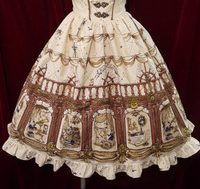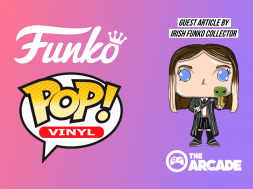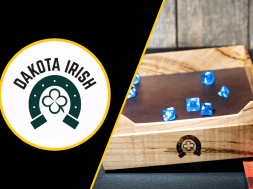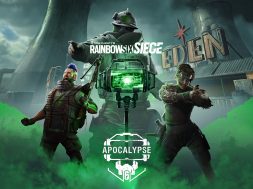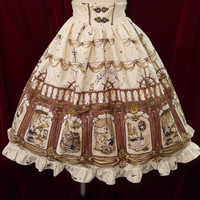
Today our guest writer, Sarah, talks to us about the lolita style and how to start out in the world of lace and frills. This three part series will cover all the bases and getting started with a bang.
For those who don’t know, lolita fashion is of Japanese origin. The lolita look began with a focus on modesty and quality in material. The original silhouette is of a knee length skirt or dress with a “cupcake” shape assisted by petticoats. Blouses, knee high socks or stockings and headdresses are also worn. Lolita fashion has evolved into several different sub styles and has a subculture that is present in many parts of the world. Our guest writer, Sarah, is the moderator of the Irish lolita community, IREGL. I’ve had the pleasure of meeting this group on a lot of occasions and I can honestly say they’re the most elegant, lovely people I’ve met. Without further ado, I’ll hand this over to Sarah to get you started on brands.
Brand vs Non-brand:
Differences in quality, pricing, and production.
The very first thing I should probably point out under this (potentially very contentious) topic is:
You do not necessarily need brand clothing to be a lolita.
So instead of giving opinions on brands and a rundown of their core styles (thus sucking all the fun out of looking at them with your own eyes), I’d rather talk about how there are several different types of clothing available. The main subsets are:
–Brand (often referred to as “burando“)
These are the designers of the Lolita World, and tend to be excellent quality and pretty expensive. (Note how I said “tend to”, as within the world of Magical Brand, there are tiers! These are things that you learn through experience, which is why the online communities are useful resources. Reviews and recommendations can help you build your knowledge, and develop a good eye for materials.)
But anyway, the general consensus is that brand is expensive but lovely.
Things to expect would be lush fabrics, high-quality lace, intricate prints, good construction, and very limited numbers. Most brand items are produced in Japan or Korea by people who are paid a decent wage, which is what pushes the price points up.
–Indie Brand and Taobao
These are smaller shops, often either just starting out, or operating on a permanently smaller business model.
Not as reliable as more established brands in terms of materials or aesthetic, but more often than not a great way to snap up a cute dress for a reasonable price.
TaoBao is essentially “eBay: China” so the pieces are factory produced in larger numbers, and while most items are perfectly fine for a few wears, they often don’t last as long as their more costly sisters. There is a fantastic master-post of TaoBao shops on EGL and a guide on HelloLace.
Indie brands tend to be run by a few girls (like we’re talking tiny staffing numbers, so patience is always handy as they can be slow or disorganized during production runs.) I really love seeing new releases from Indie brands. In recent years the scene has become really strong, and you never know, taking a chance on an indie brand could be one of your best investments. Sadly though, you need to be quick with them, as they can change name, switch ownership, or plain old disappear with lightening speed.
–Handmade
“But I heard if you wear handmade other Lolitas will shun you!”
Stop.
No.
Look up Lizchen R. Look up Lady Ludivine. Imagine trying to shun someone like that. Oh, whoops, looks like you accidentally bought them a pint instead. That happens.
This phrase is often heard from younger girls, or new seamstresses. All I can say is this: IF you are good at making your own clothes, you will earn some serious respect from about 99% of Lolitas. But Lolita clothing is elaborate, and as a result, hella difficult to sew. It’s also near impossible to get your hands on appropriately printed material by wandering the local shops, so the wise girl will opt for plain fabric at the start. It doesn’t matter how fabulous a seamstress you are, nothing can save that cupcake-print quilter’s cotton you bought in Hickey’s for €5 a meter.
This is a really difficult section for me to write on, because guess who can’t sew? (GUESS.) So my two cents on the whole “handmade” thing is: If you are good at it, I’m gonna hold you in the same regard as the people who have a license to print legal tender.
–Off Brand
This is where the lines begin to blur. Off-brand is essentially the term for stuff you find in regular stores that works well with Lolita. Accessories, socks, hair stuff, shoes, tights and bags. As a girl with size 7 feet and a metal sensitivity, I rely heavily on off-brand shoes and accessories. Just use your intuition (unless your intuition is terrible, then maybe use images from the Gothic and Lolita Bibles, you can’t go wrong if you refer directly to tried-and-true publications.)
If you’re really skilled and lucky you can even find blouses and dresses in normal stores which will actually work well in our niche fashion! This is a minefield of unsuitable silhouettes though, so take care. And as a general rule, I wouldn’t buy your main petticoat from a brick-and-mortar store in Ireland, as most underskirts you find here will either be too short, scratchy as all hell, made of stuff that loses it’s poof quickly, or just straight-up rockabilly. (You can tell I’ve made a few attempts, can’t you?)
 –Bodyline
–Bodyline
What is Bodyline?
It’s a Japanese shop? Owned by a Chinese man, with all the pieces produced in China? And not really considered to be “brand” because… quality? Lack of any discernible “seasons” when it comes to releases? Being slow to take up trends? Never being featured in the GLB or Kera magazines? WHAT???
Well the tl;dr is, Bodyline used to be a sexy shop that sold sexy costumes. They released some Lolita-ish sexy costumes. Then they started making more “proper” Lolita stuff, but it took a while for their quality and designs to evolve from “NO” to “OKAY MAYBE “. They do not follow any sort of logic (just look at that website layout) and are most useful for wardrobe filler pieces.
You will hear stories of Mr. Yan, the creepy owner with a fondness for questionably legal competitions. Make what you will of him, Bodyline has become a useful resource for everyone out there who is not made of money. But exercise caution when buying from them, avoid the model competitions, and for the love of god don’t buy the Wa-Lolita stuff. Or the Luckypacks. (13 blouse sleeves and swan-shaped sunglasses, anyone?)
–Secondhand Sales
Exactly what it sounds like. All of freak and brute creation available to buy from their previous owners. Brand, off-brand, indie, handmade, you can even request items in the hope that someone’s willing to part with their old stuff for the right price.
Often cheaper than retail, but (BUT!) not always, as here the laws of supply and demand rule supreme. They’re a great place to scout wardrobe basics or find that one random piece you like from back in 2010 while on a budget… not such a wonderful place if you’ve a taste for popular prints and status pieces. Coveted items famously go for over a thousand euro in competitive auctions, so it’s best to go in prepared for a wide variety of prices. Also, you must be savvy and make sure the sellers provide adequate detail and proof photos, because there are horror stories of girls buying things only to realize upon their arrival that the either bought a knockoff, a heavily damaged dress, a doll’s dress, or worse- they’ve just been scammed out of their money. Keep your wits about you and always look at seller’s feedback, as in a mixed market like this, quality cannot be guaranteed.
